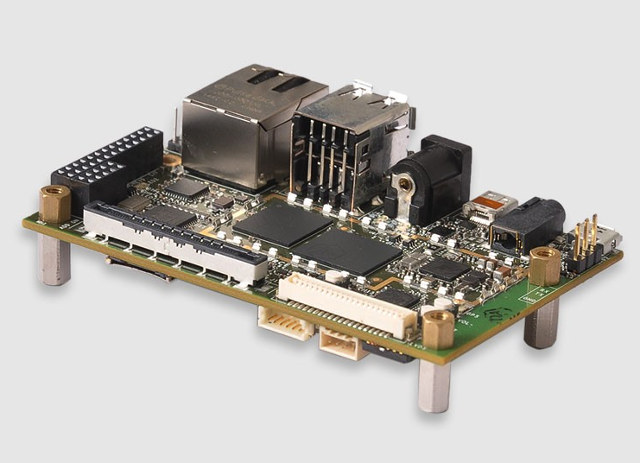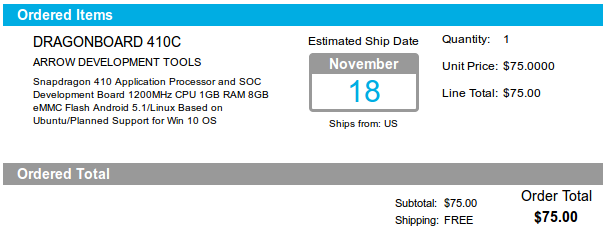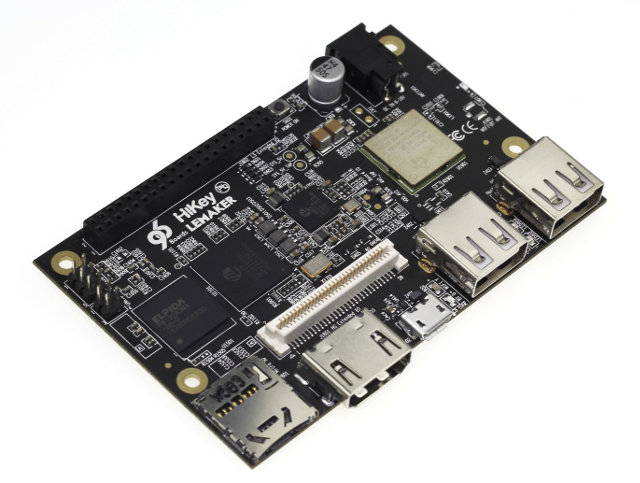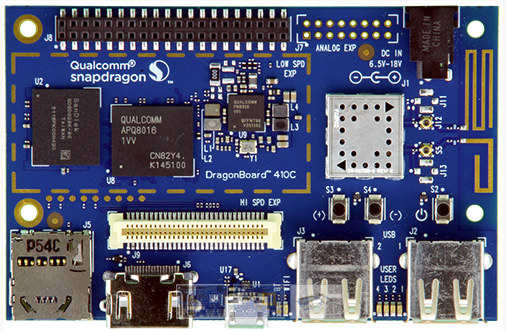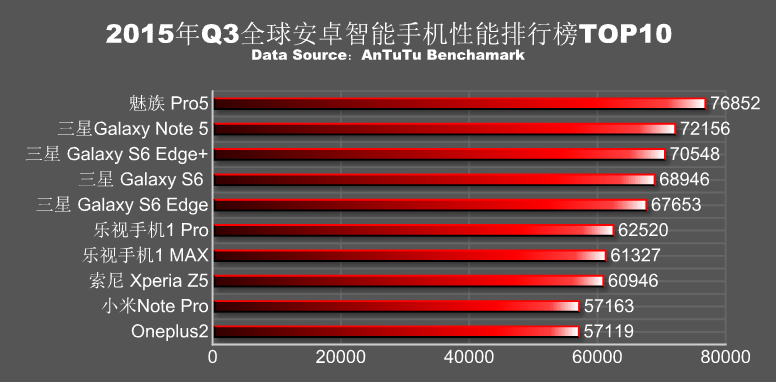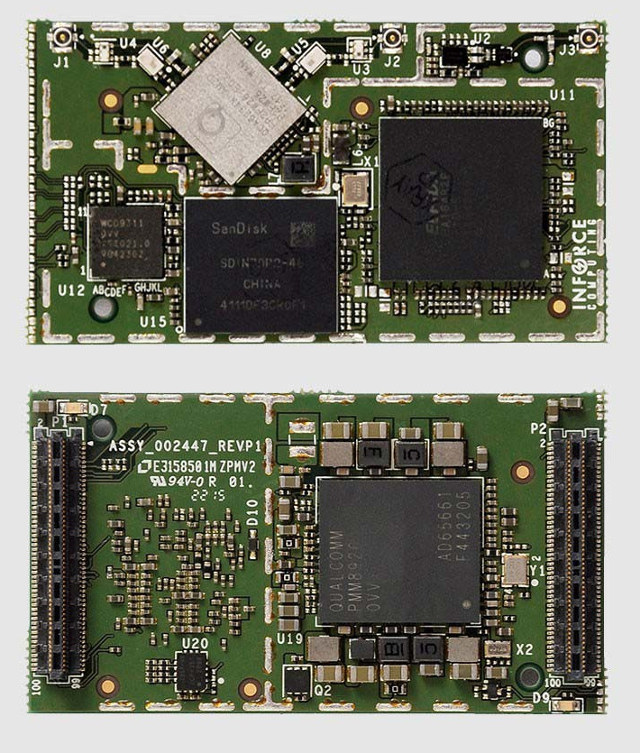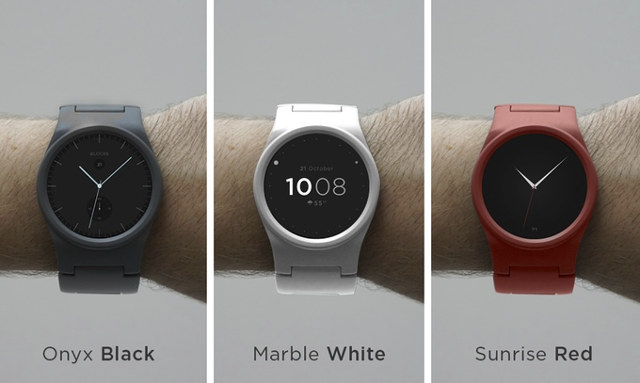I’ve recently written a review of DragonBoard 410c with Android, one of the first board part of Linaro’s 96Boards initiative that’s supposed to get Android and Debian distributions with recent Linux kernel & U-Boot, together with full source code. Inforce Computing has now launched Inforce 6309 micro Single Board Computer (SBC) with the same footprint, albeit different connectors’ placements, and software compatible with DragonBoard 410c development board powered by the same Qualcomm Snapdragon 410 processor. The board targets applications such as industrial automation, “sophisticated” IoE devices, medical devices, augmented reality computing, and robotics and drones. Inforce 6309 micro single board computer specifications: SoC- Qualcomm Snapdragon 410 (APQ8016) quad-core ARM CortexA53 @ 1.2 GHz with Adreno 306 GPU and Hexagon QDSP6 @ 700 MHz System Memory – 1GB LPDDR3 @ 533MHz, Single-channel 32-bit (4.2GBps) Storage – 8GB eMMC flash (eMCP package with RAM) + micro SD slot Video Output / Display […]
DragonBoard 410c Development Board Quick Start Guide and Android Benchmarks
Linaro’s 96Boards initiative was announced in February with the introduction of Hikey board, and while progress has been rather slow, there are now two boards available for sale: Lemaker Hikey and Qualcomm Dragonboard 410c. The main advantage of these board is that 96Boards is not only an hardware specification, but also a software specifications that mandate most code to be open source, with recent versions of Linux and U-boot, and in the case of Dragonboard 410c work is being done with Freedreno open source GPU drivers. Now that I’ve got a board I’ll explain my experience with the purchasing process, take a few pictures, and show how to get started with Android, and install the latest version, before running a few benchmarks. Ordering DragonBoard 410c Development Board I normally don’t like purchasing from North American and European distributors, because of the potential documentation involved to comply with silly laws, high […]
Linaro Releases the First (Alpha) Version of the 96Boards Reference Software Platform
Linaro’s 96Boards initiative was launched at the beginning of the year with Hikey board, and beside the hardware specifications, 96Boards also has some software requirements that include support for “bootloader (open source), accelerated graphics support (binary or open source), a Linux kernel buildable from source code based from mainline, or the latest Google-supported Android kernel version, or the last two LTS kernels, and one of more of the following operating systems: Android, Debian/Ubuntu, Fedora/Red Hat, or an OpenEmbedded/Yocto build of a Linux distribution”. In order to achieve this goal, Linaro introduced the Reference Software Platform for 96Boards, and they’ve now pushed the first Alpha release for Hikey and DragonBoard 410c boards. The release includes a bootloader, the Linux kernel, Debian and AOSP with firmware, source code, and documentation. Some highlights of the Reference Software Platform 15.10 Alpha release include: CE Debian RPB (Reference Platform Build) Debian 8.2 “Jessie” Linux 4.3 […]
Linux 4.3 Release – Main Changes, ARM and MIPS Architectures
Linus Torvalds released Linux Kernel 4.3 last week-end: So it *felt* like the last week of the rc series was busy, to the point where I got a bit worried about the release. But doing the actual numbers shows that that really was just my subjective feeling, probably due to the kernel summit and travel back home from Korea. It wasn’t actually a particularly busy week, it’s just that the pull requests were more noticeable in the last couple of days. We had a network update and a late fix for a x86 vm86 mode bug introduced by the vm86 cleanups, but other than that it’s just a collection of various small one-liners all over. Ok, the vm86 mode thing was a one-liner too, it was just slightly more nerve-wracking because it looked scarier than it was before people (Andy) figured out what was going on. The changes from rc7 […]
Qualcomm DragonBoard 410c Board Now Supports Windows 10 IoT Core
Microsoft announced Windows 10 IoT Core for Raspberry Pi 2 and Minnowboard MAX boards a few months, and now the company has added a new ARM board to their Windows 10 IoT program with the soon-to-be-available Qualcomm DragonBoard 410c development board compliant with 96Boards specifications. Windows 10 IoT Core for DragonBoard 410c adds support for onboard WiFi and Bluetooth, as well as DirectX graphics on top of features already supported on the Raspberry Pi 2. To get started, you’ll need a computer running Windows 10, and follow DragonBoard’s Winfows 10 IoT Core guide. I assume most people familiar with Linux operating systems won’t suddenly jump ship to run a Windows operating systems, but Windows developers who got used to work with Visual Studio may be more comfortable with Microsoft’s environment. Out of curiosity, I’ve checked out if anybody had done any project with Windows 10 IoT core, and was surprised […]
Top 10 Antutu Scores of 2015 for Smartphones So Far
I’m mainly focusing on Android mini PCs, and not so much on mobile devices. But this year, silicon vendors launched 64-bit ARM processor for TV boxes based on the low power Cortex A53 cores, lowering costs instead of improving performance of their 32-bit ARM processors, as media player don’t usually need very fast processor simply because video decoding is normally handled by the video engine. Two exceptions being Amazon Fire TV 2015 which gets over 51,000 points mostly thanks to MediaTek MT8173‘s two Cortex A72 cores, and Nvidia Shield Android TV box getting over 68,000 points, but sadly these two devices are not (easily) available worldwide yet. But on the mobile space, the race to faster and faster performance is still on, and according to a recent post on Antutu website (in Chinese), the fastest smartphones now reach over 75,000 points in the popular benchmark. I had to look up the […]
Inforce Computing 6401 Micro SOM is a Qualcomm Snapdragon 600 System-on-Module
Inforce Computing announced their 6501 Micro SOM system-on-module based on Qualcomm Snapdragon 805 processor in Q2 2015, and the company informed me that they had just unveiled a lower power version based on Snapdragon 600 processor called 6401 Micro SOM, and still featuring WiFi, Bluetooth 4.0, and GPS connectivity on module. Inforce 6401 Micro SOM: SoC – Qualcomm Snapdragon 600 (APQ8064) quad core Krait processor up to 1.7 GHz with Adreno 320 GPU, and Hexagon DSP v4 up to 500MHz System Memory – 2GB PoP LPDDR2 @533Mhz (Optional 3GB) Storage – 4GB eMMC v4.4.1/v4.5, with options up to 64GB Connectivity – BT 4.0 , dual band 802.11n/ac Wi-Fi (QCA6234), and GPS (WGR7640) with WiFi and GPS antennas on carrier board Peripherals and I/O via two 100-pin SoM connectors: Video / Display – 1x HDMI, 2x MIPI-DSI (4-lane) & touch screen Audio 4x Line out, 3x Mic-in, 1x headphone out 8-channel […]
BLOCKS Modular Smartwatch Replaces the Watchband With Smart Modules (Crowdfunding)
While Project Ara aims to create a modular smartphone, the guys behind BLOCKS have designed a modular smartwatch with the Core (the main watch) and various hot swappable smart modules that clip together with a clasp make the watch band. BLOCKS’ Core specifications: SoC – Qualcomm Snapdragon 400 processor System Memory – 512 MB RAM Storage – 4GB flash (ePoP) Display – 1.36″ round display, resolution: 360 pixels diameter Connectivity – 802.11 b/g/n and Bluetooth 4.0 Sensors – Accelerometer / Gyro Audio – Microphone Misc – Power button, vibration motor IP Rating – IP67 (but target is IP68) Battery – 400 mAh battery; good for ~1.5 days on a charge Dimensions – TBD Weight – TBD So the Core module is already a standalone smartwatch on its own, and they do provide one without module, but just a simple strap. The watch runs a modified version of Android Lollipop, and […]


